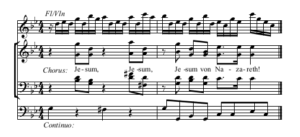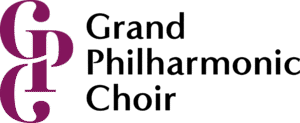 The St. John Passion was heard for the first time on Good Friday, April 7, 1724, almost exactly three hundred years ago, in Leipzig’s Nicolaikirche, one of the churches for which Bach was responsible for providing music. Elaborate Passion settings hadn’t yet been a long tradition on Good Friday in Leipzig, when Bach arrived in 1723. His predecessor Johann Kuhnau presented a Passion in 1721 and a setting by an unidentified composer, maybe Telemann, had been sung in 1717. When Bach presented his St. John Passion in 1724, his first Holy Week in Leipzig, the piece had no precedent. Its length, scope and dramatic nature exceeded anything that anyone could imagine. It was modern. It was operatic, and it was a challenge to the congregants who had gathered to hear this new work in the context of a liturgical service. Many congregants were irritated and mystified by what they heard. It wasn’t suitable for such a solemn occasion. It was music that belonged in the opera house.
The St. John Passion was heard for the first time on Good Friday, April 7, 1724, almost exactly three hundred years ago, in Leipzig’s Nicolaikirche, one of the churches for which Bach was responsible for providing music. Elaborate Passion settings hadn’t yet been a long tradition on Good Friday in Leipzig, when Bach arrived in 1723. His predecessor Johann Kuhnau presented a Passion in 1721 and a setting by an unidentified composer, maybe Telemann, had been sung in 1717. When Bach presented his St. John Passion in 1724, his first Holy Week in Leipzig, the piece had no precedent. Its length, scope and dramatic nature exceeded anything that anyone could imagine. It was modern. It was operatic, and it was a challenge to the congregants who had gathered to hear this new work in the context of a liturgical service. Many congregants were irritated and mystified by what they heard. It wasn’t suitable for such a solemn occasion. It was music that belonged in the opera house.
The music contained in the St. John Passion is no less challenging to an audience today, some three hundred years later. It is beautiful, sublime and comforting, but it is in equal measures disturbing, dark and raw. Bach confronts the listener with almost every human emotion and human shortcoming contained in this Passion story. He confronts us, his listeners, with Peter’s impulsiveness, silence, and lack of courage to speak up as though they are our own. He confronts us with Pilate’s struggle to see what is right and just. He confronts us with the soldiers at the foot of the cross, casting lots, indifferent to the injustice taking place right in front of them. He also confronts the listener with the grief of a mother, losing a son, and with the consolation of collective mourning. In this musical setting of a divine story, there is also so much humanity.
It must be acknowledged, too, that the same words that can be reflective and contemplative for some have also, for centuries, been a source of anti-Jewish sentiment and have given rise to anti-Jewish action. John’s Passion account, and Bach’s musical setting of it, repeatedly identifies the Jewish people as those responsible for Jesus’ death. Bach holds back no punches in that. The painful cries of “weg, weg, mit dem, mit dem, weg, weg, kreuzige ihn” (Away with him! Crucify him!) are given some of the most aggressive and violent notes in music. It must be said that this story, which holds an important place of reflection for so many at this time of year, has also caused much pain and has increased hatred towards Jewish communities around the world. This makes the St. John Passion, whose libretto uses John’s account word for word, a complicated piece to program in modern times. For this reason, we have compiled some helpful resources on this page to help provide some commentary and context surrounding Bach’s St. John Passion.
What do we do about Bach’s St. John Passion, by Robert Harris from the Tafelmusik website
Bach’s St. John Passion and the Jews, by Michael Marissen from the Yale Institute of Sacred Music website
Why the Bach Passions Are Problematic from the Chorus America website
Anti-Semitism and Bach’s St. John Passion from Case Western Reserve University’s website
Redeeming the St. John Passion, by Robert Marshall, from Commentary’s website
If you missed the pre-concert talk given by Dr. Allen Jorgenson before our March 29th performance, you can listen to it here. Our thanks to Dr. Jorgenson for agreeing to share it.
Programme notes for the upcoming concert on March 29th
Then Jesus, knowing all that was to happen to him, came forward and asked them, “Whom are you looking for?”
John 18.4
J.S. Bach’s Johannes-Passion follows in the footsteps of centuries of musical settings of the biblical narrative having to do with the arrest, trial and crucifixion of Jesus Christ. These sacred texts, by papal decree, have been part of Holy Week liturgies since the fourth century. By the ninth century, manuscripts reveal that indications for the tempo, relative pitch and volume of the recitation of these texts had been prescribed. In the 12th century, fixed pitches for the words of the Evangelist, Christ, and the crowds had been set by using symbolic letters in the margins. These printed rubrics are the precursors to fully composed polyphonic settings, which abound in the voice of all four Gospel-tellers from at least the fifteenth century on. Known as the Passion, these texts form the backbone of the Christian faith and have served as the seeds of profound musical composition for centuries.
From the middle of the 17th century, composers began to add non-biblical texts to the Passion in the form of arias and choruses as well as independent instrumental movements. In Protestant Germany, Lutheran hymns or chorales were added, whose reflective texts and melodies would have been familiar to all congregants. It is this heritage that Bach inherited.
The Johannes-Passion was first performed, by Bach, in Leipzig on Good Friday, 7 April, 1724, almost exactly 300 years ago. While the tradition of concerted Passion settings was steadily growing throughout Germany in the 18th century (even in conservative Leipzig, Passion settings had been composed and performed by Bach’s predecessor, Johann Kuhnau) the Johannes-Passion was Bach’s first setting of the Passion text and first major work written in his new post at Leipzig. It was performed during the Good Friday liturgy, of which the singing of the Passion was only one part. The worship service, at the Nicolaikirche, began with the singing of the hymn, Da Jesus an dem Kreuze stund (When Jesus hung upon the cross), a 9-stanza hymn, the verses of which contain the Seven Last Words of Christ. Congregants would have endured an arduous, hour-long sermon between the first part of the Passion and the second. Other music was also heard in the liturgy as well. In a Leipzig tradition, Jacob Handl’s beautifully simple setting of Isaiah 57.1-2, Ecce, quomodo moritur justus (Behold, the righteous man perishes) traditionally followed the singing of the Passion; and Bach, too, carried on this practice following the finale chorale of his St. John Passion. The liturgy concluded with the singing of the hymn Nun danket alle Gott (Now thank we all our God).
For the text of the Passion, Bach turns to chapters 18 and 19 of John’s Gospel. John’s was the last account to be written, perhaps as late as 70 or 80 CE, and is quite different than the other so-called synoptic gospels. It is concerned with a mystical, philosophical Jesus and calls into play Jesus’ own prophetic words as predictions of the events leading to the Crucifixion (eg. In order that the Word would be fulfilled, which he said, “I have not lost one of those whom you have given me.” John 18.9). In fact, the drama and action of the Passion narrative unfolds with John’s statement that Jesus “knew everything that was supposed to happen to him” (John 18.4) ringing in the listener’s ear. In other words, it is John’s suggestion that the Passion narrative was to take place according to a preordained plan; by looking at John’s Passion in this light, the perspective of the events that unfold turn upside down. Seen this way, the key players surrounding Christ through the Passion (the soldiers, the Jews, the Chief Priests, and Pilate, for example) are not aggressors; they bear no more responsibility for his crucifixion than anyone else. This is a particularly important distinction for the repeated labeling in John’s Gospel of “the Jews” rather than “the crowd” or “the people,” as in Matthew’s account. This labeling resulted, early on, in the portrayal of the Jewish people as the enemies of Christ, which, in turn, contributed to centuries of anti-Semitic response by the Christian church. It is, of course, a long and complicated history. Rather, these “players” are part of an unfolding plan that Christ already knows. Taking his cue from Christ’s resignation, that the events of the Passion are, in fact, already in motion and will, assuredly, lead directly to the cross, Bach constructs a musical architecture that recognizes this unique perspective of Johannine theology.
A musical motif appears in a chorus early on the work, which is characterized by an almost frenetic passage of 16th notes played by the flutes and violins and supported harmonically by a familiar-sounding circle of fifths progression; it lasts only four bars. Jesus asks the soldiers in the Garden of Gethsemene for whom they are looking? The chorus responds: Jesum von Nazareth! (Jesus of Nazareth!). It is this music that becomes a ‘leitmotiv’ of sorts. In five separate choruses, Bach repeats this music, each time with a different text.

Bach’s early listeners may not have recognized that they were hearing the same music throughout the Johannes-Passion, but a sense that they were listening to something familiar must have struck them, at least subconsciously. Bach pairs and repeats chorus material on four other occasions, with a similar purpose at hand. By bringing the listeners into an unfolding drama with musical motifs they have already heard, Bach recalls, musically, John’s assertion that Jesus knew “all that was to happen to him.” What emerges in Bach’s beautiful and dramatic setting is a narrative of deeply human emotion, and a masterpiece of musical architecture where the events leading to Christ’s crucifixion are a freeing act of love.
NOTES by Mark Vuorinen

